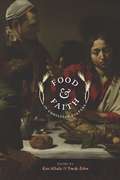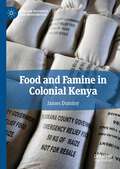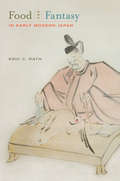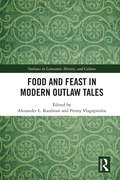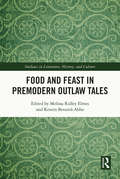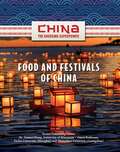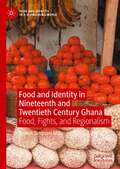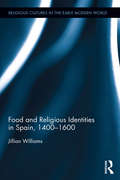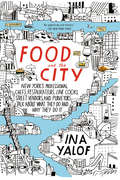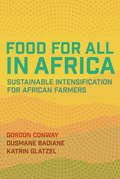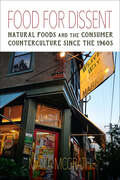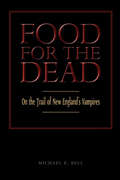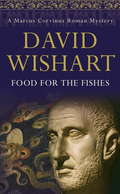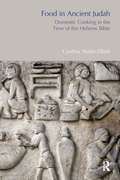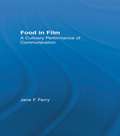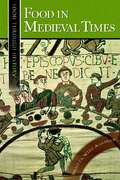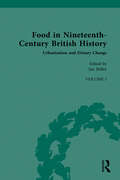- Table View
- List View
Food and Faith in Christian Culture (Arts and Traditions of the Table: Perspectives on Culinary History)
by Ken Albala Trudy EdenWithout a uniform dietary code, Christians around the world used food in strikingly different ways, developing widely divergent practices that spread, nurtured, and strengthened their religious beliefs and communities. Featuring never-before published essays, this anthology follows the intersection of food and faith from the fourteenth to the twenty-first century, charting the complex relationship among religious eating habits and politics, culture, and social structure.Theoretically rich and full of engaging portraits, essays consider the rise of food buying and consumerism in the fourteenth century, the Reformation ideology of fasting and its resulting sanctions against sumptuous eating, the gender and racial politics of sacramental food production in colonial America, and the struggle to define "enlightened" Lenten dietary restrictions in early modern France. Essays on the nineteenth century explore the religious implications of wheat growing and breadmaking among New Zealand's Maori population and the revival of the Agape meal, or love feast, among American brethren in Christ Church. Twentieth-century topics include the metaphysical significance of vegetarianism, the function of diet in Greek Orthodoxy, American Christian weight loss programs, and the practice of silent eating rituals among English Benedictine monks. Two introductory essays detail the key themes tying these essays together and survey food's role in developing and disseminating the teachings of Christianity, not to mention providing a tangible experience of faith.
Food and Famine in Colonial Kenya (African Histories and Modernities)
by James DuminyThis book offers a genealogical critique of how food scarcity was governed in colonial Kenya. With an approach informed by the ‘analysis of government’, the study accounts for the emergence and persistence of dominant approaches to promoting food security in Kenya and elsewhere in Africa – policies and practices that prioritize increased agricultural production as the principal means of achieving food security. Drawing on a range of archival sources, the book investigates how those tasked with governing colonial Kenya confronted food as a particular kind of problem. It emphasizes the ways in which that problem shifted in conjunction with the emergence and consolidation of the colonial state and economic relations in the territory. The book applies a novel conceptual approach to the historical study of African food systems and famine, and provides the first longitudinal and in-depth analysis of the dynamics of food scarcity and its government in Kenya.
Food and Fantasy in Early Modern Japan
by Eric RathHow did one dine with a shogun? Or make solid gold soup, sculpt with a fish, or turn seaweed into a symbol of happiness? In this fresh look at Japanese culinary history, Eric C. Rath delves into the writings of medieval and early modern Japanese chefs to answer these and other provocative questions, and to trace the development of Japanese cuisine from 1400 to 1868. Rath shows how medieval "fantasy food" rituals--where food was revered as symbol rather than consumed--were continued by early modern writers. The book offers the first extensive introduction to Japanese cookbooks, recipe collections, and gastronomic writings of the period and traces the origins of dishes like tempura, sushi, and sashimi while documenting Japanese cooking styles and dining customs.
Food and Feast in Modern Outlaw Tales (Outlaws in Literature, History, and Culture)
by Penny Vlagopoulos Alexander L. KaufmanThis collection of scholarly essays presents new work from in an emerging line of inquiry: modern outlaw narratives and the textual and cultural relevance of food and feasting. Food, its preparation and its consumption, is presented in outlaw narratives as central points of human interaction, community, conflict, and fellowship. Feast scenes perform a wide variety of functions, serving as cultural repositories of manners and behaviors, catalysts for adventure, or moments of regrouping and redirecting narratives. The book argues that modern outlaw narratives illuminate a potent cross-cultural need for freedom, solidarity, and justice, and it examines ways in which food and feasting are often used to legitimate difference, create discord, and manipulate power dynamics.
Food and Feast in Premodern Outlaw Tales (Outlaws in Literature, History, and Culture #8)
by Melissa Ridley Elmes Kristin Bovaird-AbboIn Food and Feast in Premodern Outlaw Tales editors Melissa Ridley Elmes and Kristin Bovaird-Abbo gather eleven original studies examining scenes of food and feasting in premodern outlaw texts ranging from the tenth through the seventeenth centuries and forward to their cinematic adaptations. Along with fresh insights into the popular Robin Hood legend, these essays investigate the intersections of outlawry, food studies, and feasting in Old English, Middle English, and French outlaw narratives, Anglo-Scottish border ballads, early modern ballads and dramatic works, and cinematic medievalism. The range of critical and disciplinary approaches employed, including history, literary studies, cultural studies, food studies, gender studies, and film studies, highlights the inherently interdisciplinary nature of outlaw narratives. The overall volume offers an example of the ways in which examining a subject through interdisciplinary, cross-geographic and cross-temporal lenses can yield fresh insights; places canonic and well-known works in conversation with lesser-known texts to showcase the dynamic nature and cultural influence and impact of premodern outlaw tales; and presents an introductory foray into the intersection of literary and food studies in premodern contexts which will be of value and interest to specialists and a general audience, alike.
Food and Festivals of China (China: The Emerging Superpower)
by Yan LiaoHave you ever seen the boisterous lion dances or heard the multitude of firecrackers in Chinatown during the Chinese New Year? Did you ever wonder what kind of festivals and holidays the Chinese people celebrate? This book takes a look at the fascinating world of Chinese food and festivals. It introduces the most popular traditional festivals celebrated by Chinese people all over the globe, including the Spring Festival (Chinese New Year), the Dragon Boat Festival, the Mid-Autumn Festival, and two "festivals of the dead." It also examines intriguing ethnic festivals celebrated by some of China's 55 officially recognized minority peoples. Discover the customs, legends, and traditional food and treats of these festivals. Share the excitement of the celebration with one-fifth of the world's population, and enjoy the liveliest component of a 4,000-year-old civilization!
Food and Festivals: India
by Mike HirstINDIA Let your mouth water and your tastebuds tingle as you find out all about Indian food and festivals in this book. Did you know that throwing rice at newlyweds comes from a tradition at weddings in India? Choose which gifts of candies you would like to receive at the festival of Diwali. Try the festival recipes inside to taste the flavor of INDIA.
Food and Identity in Nineteenth and Twentieth Century Ghana: Food, Fights, and Regionalism (Food and Identity in a Globalising World)
by Brandi Simpson MillerThis book investigates how cooking, eating, and identity are connected to the local micro-climates in each of Ghana’s major eco-culinary zones. The work is based on several years of researching Ghanaian culinary history and cuisine, including field work, archival research, and interdisciplinary investigation. The political economy of Ghana is used as an analytical framework with which to investigate the following questions: How are traditional food production structures in Ghana coping with global capitalist production, distribution, and consumption? How do land, climate, and weather structure or provide the foundation for food consumption and how does that affect the separate traditional and capitalist production sectors? Despite the post WWII food fight that launched Ghana’s bid for independence from the British empire, Ghana’s story demonstrates the centrality of local foods and cooking to its national character. The cultural weight of regional traditional foods, their power to satisfy, and the overall collective social emphasis on the ‘proper’ meal, have persisted in Ghana, irrespective of centuries of trade with Europeans. This book will be of interest to scholars in food studies, comparative studies, and African studies, and is sure to capture the interest of students in new ways.
Food and Knowledge in Renaissance Italy: Bartolomeo Scappi's Paper Kitchens (Visual Culture In Early Modernity Ser.)
by Deborah L KrohnThough Bartolomeo Scappi's Opera (1570), the first illustrated cookbook, is well known to historians of food, up to now there has been no study of its illustrations, unique in printed books through the early seventeenth century. In Food and Knowledge in Renaissance Italy, Krohn both treats the illustrations in Scappi's cookbook as visual evidence for a lost material reality; and through the illustrations, including several newly-discovered hand-colored examples, connects Scappi's Opera with other types of late Renaissance illustrated books. What emerges from both of these approaches is a new way of thinking about the place of cookbooks in the history of knowledge. Krohn argues that with the increasing professionalization of many skills and trades, Scappi was at the vanguard of a new way of looking not just at the kitchen-as workshop or laboratory-but at the ways in which artisanal knowledge was visualized and disseminated by a range of craftsmen, from engineers to architects. The recipes in Scappi's Opera belong on the one hand to a genre of cookery books, household manuals, and courtesy books that was well established by the middle of the sixteenth century, but the illustrations suggest connections to an entirely different and emergent world of knowledge. It is through study of the illustrations that these connections are discerned, explained, and interpreted. As one of the most important cookbooks for early modern Europe, the time is ripe for a focused study of Scappi's Opera in the various contexts in which Krohn frames it: book history, antiquarianism, and visual studies.
Food and Religious Identities in Spain, 1400-1600 (Religious Cultures in the Early Modern World)
by Jillian WilliamsIn the late fourteenth century, the Iberian Peninsula was home to three major religions which coexisted in relative peace. Over the next two centuries, various political and social factors changed the face of Iberia dramatically. This book examines this period of dynamic change in Iberian history through the lens of food and its relationship to religious identity. It also provides a basis for further study of the connection between food and identities of all types. This study explores the role of food as an expression of religious identity made evident in things like fasting, feasting, ingredient choices, preparation methods and commensal relations. It considers the role of food in the formation and redefinition of religious identities throughout this period and its significance in the maintenance of ideological and physical boundaries between faiths. This is an insightful and unique look into inter-religious dynamics. It will therefore be of great interest to scholars of religious studies, early modern European history and food studies.
Food and Theatre on the World Stage (Routledge Advances in Theatre & Performance Studies)
by Ann Folino White Dorothy ChanskyPutting food and theatre into direct conversation, this volume focuses on how food and theatre have operated for centuries as partners in the performative, symbolic, and literary making of meaning. Through case studies, literary analyses, and performance critiques, contributors examine theatrical work from China, Japan, India, Greece, Italy, France, Germany, England, the United States, Chile, Argentina, and Zimbabwe, addressing work from classical, popular, and contemporary theatre practices. The investigation of uses of food across media and artistic genres is a burgeoning area of scholarly investigation, yet regarding representation and symbolism, literature and film have received more attention than theatre, while performance studies scholars have taken the lead in examining the performative aspects of food events. This collection looks across dramatic genres, historical periods, and cultural contexts, and at food in all of its socio-political, material complexity to examine the particular problems and potentials of invoking and using food in live theatre. The volume considers food as a transhistorical, global phenomenon across theatre genres, addressing the explosion of food studies at the end of the twentieth century that has shown how food is a crucial aspect of cultural identity.
Food and War in Mid-Twentieth-Century East Asia
by Katarzyna J. CwiertkaWar has been both an agent of destruction and a catalyst for innovation. These two, at first sight contradictory, yet mutually constitutive outcomes of war-waging are particularly pronounced in twentieth-century Asia. While 1945 marked the beginning of peaceful recovery for Europe, military conflicts continued to play a critical role in the historical development of this part of the world. In essence, all wars in twentieth-century Asia stemmed from the political vacuum that developed after the fall of the Japanese Wartime Empire, intricately connecting one region with another. Yet, they have had often very diverse consequences, shattering the homes of some and bringing about affluence to others. Disarray of war may halt economic activities and render many aspects of life insignificant. The need for food, however, cannot be ignored and the social action that it requires continues in all circumstances. This book documents the effects of war on the lives of ordinary people through the investigation of a variety of connections that developed between war-waging and the production, distribution, preparation and consumption of food throughout Asia since the 1930s. The topics addressed range from issues at stake at the time of the conflicts, such as provisioning the troops and food rationing and food relief for civilians, to long-term, often surprising consequences of war waging and wartime mobilization of resources on the food systems, diets, and tastes of the societies involved. The main argument of this volume is that war has not been a mere disruption, but rather a central force in the social and cultural trajectories of twentieth-century Asia. Due to its close connection with human nourishment and comfort, food stands central in the life of the individual. On the other hand, owing to its connection with profit and power, food plays a critical role in the social and economic organization of a society. What happens to food and eating is, therefore, an important index of change, a privileged basis for the exploration of historical processes.
Food and the City: New York's Professional Chefs, Restaurateurs, Line Cooks, Street Vendors, and Purveyors Talk About What They Do and Why They Do It
by Ina YalofAn unprecedented behind-the-scenes tour of New York City's dynamic food culture, as told through the voices of the chefs, line cooks, restaurateurs, waiters, and street vendors who have made this industry their lives. In Food and the City, Ina Yalof takes us on an insider's journey into New York's pulsating food scene alongside the men and women who call it home. Dominique Ansel declares what great good fortune led him to make the first cronut. Lenny Berk explains why Woody Allen's mother would allow only him to slice her lox at Zabar's. Ghaya Oliveira, who came to New York as a young Tunisian stockbroker, opens up about her hardscrabble yet swift trajectory from dishwasher to executive pastry chef at Daniel. Restaurateur Eddie Schoenfeld describes his journey from Nice Jewish Boy from Brooklyn to New York's Indisputable Chinese Food Maven.From old-schoolers such as David Fox, third-generation owner of Fox's U-bet syrup, and the outspoken Upper West Side butcher "Schatzie," to new kids on the block including Patrick Collins, sous chef at The Dutch, and Brooklyn artisan Lauren Clark of Sucre Mort Pralines, Food and the City is a fascinating oral history with an unforgettable gallery of New Yorkers who embody the heart and soul of a culinary metropolis.From the Hardcover edition.
Food and the City: New York's Professional Chefs, Restaurateurs, Line Cooks, Street Vendors, and Purveyors Talk About What They Do and Why They Do It
by Ina YalofA behind-the-scenes tour of New York City's dynamic food culture, as told through the voices of the chefs, line cooks, restaurateurs, waiters, and street vendors who have made this industry their lives."A must-read -- both for those who live and dine in NYC and those who dream of doing so." --Bustle"[A] compelling volume by a writer whose beat is not food . . . with plenty of opinions to savor." --Florence Fabricant, The New York TimesIn Food and the City, Ina Yalof takes us on an insider's journey into New York's pulsating food scene alongside the men and women who call it home. Dominique Ansel declares what great good fortune led him to make the first Cronut. Lenny Berk explains why Woody Allen's mother would allow only him to slice her lox at Zabar's. Ghaya Oliveira, who came to New York as a young Tunisian stockbroker, opens up about her hardscrabble yet swift trajectory from dishwasher to executive pastry chef at Daniel. Restaurateur Eddie Schoenfeld describes his journey from Nice Jewish Boy from Brooklyn to New York's Indisputable Chinese Food Maven.From old-schoolers such as David Fox, third-generation owner of Fox's U-bet syrup, and the outspoken Upper West Side butcher "Schatzie" to new kids on the block including Patrick Collins, sous chef at The Dutch, and Brooklyn artisan Lauren Clark of Sucre Mort Pralines, Food and the City is a fascinating oral history with an unforgettable gallery of New Yorkers who embody the heart and soul of a culinary metropolis.From the Hardcover edition.
Food for All in Africa: Sustainable Intensification for African Farmers
by Ousmane Badiane Gordon Conway Katrin GlatzelAfrica requires a new agricultural transformation that is appropriate for Africa, that recognizes the continent's diverse environments and climates, and that takes into account its histories and cultures while benefiting rural smallholder farmers and their families.In this boldly optimistic book, Sir Gordon Conway, Ousmane Badiane, and Katrin Glatzel describe the key challenges faced by Africa's smallholder farmers and present the concepts and practices of Sustainable Intensification (SI) as opportunities to sustainably transform Africa's agriculture sector and the livelihoods of millions of smallholders. The way forward, they write, will be an agriculture sector deeply rooted within SI: producing more with less, using fertilizers and pesticides more prudently, adapting to climate change, improving natural capital, adopting new technologies, and building resilience at every stage of the agriculture value chain.Food for All in Africa envisions a virtuous circle generated through agricultural development rooted in SI that results in greater yields, healthier diets, improved livelihoods for farmers, and sustainable economic opportunities for the rural poor that in turn generate further investment. It describes the benefits of digital technologies for farmers and the challenges of transforming African agricultural policies and creating effective and inspiring leadership.Food for All in Africa demonstrates why we should take on the challenge and provides ideas and methods through which it can be met.
Food for Dissent: Natural Foods and the Consumer Counterculture Since the 1960s
by Maria McGrathIn the 1960s and early 1970s, countercultural rebels decided that, rather than confront the system, they would create the world they wanted. The natural foods movement grew out of this contrarian spirit. Through a politics of principled shopping, eating, and entrepreneurship, food revolutionaries dissented from corporate capitalism and mainstream America. In Food for Dissent, Maria McGrath traces the growth of the natural foods movement from its countercultural fringe beginning to its twenty-first-century "food revolution" ascendance, focusing on popular natural foods touchstones—vegetarian cookbooks, food co-ops, and health advocates. Guided by an ideology of ethical consumption, these institutions and actors spread the movement's oppositionality and transformed America's foodscape, at least for some. Yet this strategy proved an uncertain instrument for the advancement of social justice, environmental defense, and anti-corporatism. The case studies explored in Food for Dissent indicate the limits of using conscientious eating, shopping, and selling as tools for civic activism.
Food for People, Not for Profit
by Michael Jacobson Catherine LerzaA sourcebook for the Food Crisis. Includes a preface by Ralph Nader.
Food for the Dead: On the Trail of New England’s Vampires (Garnet Bks.)
by Michael E. BellFor nineteenth-century New Englanders, "vampires" lurked behind tuberculosis. To try to rid their houses and communities from the scourge of the wasting disease, families sometimes relied on folk practices, including exhuming and consuming the bodies of the deceased. Author and folklorist Michael E. Bell spent twenty years pursuing stories of the vampire in New England. While writers like H. P. Lovecraft, Henry David Thoreau, and Amy Lowell drew on portions of these stories in their writings, Bell brings the actual practices to light for the first time. He shows that the belief in vampires was widespread, and, for some families, lasted well into the twentieth century. With humor, insight, and sympathy, he uncovers story upon story of dying men, women, and children who believed they were food for the dead. This Wesleyan paperback edition includes an extensive preface by the author unveiling some of the new cases he's learned about since Food for the Dead was first published in 2001.
Food for the Fishes
by David WishartWhen Licinius Murena, wealthy owner of a fish-farm, is found dead, drowned in one of his own eel tanks, not many tears are shed. Certainly not by Trebbio, who had just been booted out of his cottage by the landowner, and was heard bad-mouthing him drunkenly in public the day before Murena's death. Nor by the widow, a little stunner half Murena's age who allegedly spent an inordinate amount of time 'under the doctor'. Nor by his daughter or his farm manager. With friends like these, who needs enemies? Marcus Corvinus is the man to find out. With the help, of course, of his clever wife Perilla - if she can spare the time from her newly acquired passion for gambling . . . As we follow the Byzantine thought processes by which our hero solves the crime, we are entertained along with way with accounts of pisciculture and with a handy guide to 'Twelve Lines', the Roman precursor of backgammon.
Food for the Fishes
by David WishartWhen Licinius Murena, wealthy owner of a fish-farm, is found dead, drowned in one of his own eel tanks, not many tears are shed. Certainly not by Trebbio, who had just been booted out of his cottage by the landowner, and was heard bad-mouthing him drunkenly in public the day before Murena's death. Nor by the widow, a little stunner half Murena's age who allegedly spent an inordinate amount of time 'under the doctor'. Nor by his daughter or his farm manager. With friends like these, who needs enemies? Marcus Corvinus is the man to find out. With the help, of course, of his clever wife Perilla - if she can spare the time from her newly acquired passion for gambling . . . As we follow the Byzantine thought processes by which our hero solves the crime, we are entertained along with way with accounts of pisciculture and with a handy guide to 'Twelve Lines', the Roman precursor of backgammon.
Food in Ancient Judah: Domestic Cooking in the Time of the Hebrew Bible
by Cynthia Shafer-ElliottFirst published in 2013. The study of food in the Hebrew Bible and Syro-Palestinian archaeology has tended to focus on kosher dietary laws, the sacrificial system, and feasting in elite contexts. More everyday ritual and practice - the preparation of food in the home - has been overlooked. Food in Ancient Judah explores both the archaeological remains and ancient Near Eastern sources to see what they reveal about the domestic gastronomical daily life of ancient Judahites within the narratives of the Hebrew Bible. Beyond the findings, the methodology of the study is in itself innovative. Biblical passages that deal with domestic food preparation are translated and analysed. Archaeological findings and relevant secondary resources are then applied to inform these passages. Food in Ancient Judah reflects both the shift towards the study of everyday life in biblical studies and archaeology and the huge expansion of interest in food history - it will be of interest to scholars in all these fields
Food in Film: A Culinary Performance of Communication (Studies in American Popular History and Culture)
by Jane FerryFirst published in 2003. Routledge is an imprint of Taylor & Francis, an informa company.
Food in Medieval Times
by Melitta Weiss AdamsonFew medieval cookbooks have survived from earlier than the 14th century and those typically reflect the cuisine of the elite. In a study of culture in the Middle Ages viewed through food-related themes, Adamson (modern languages and literatures, U. of Western Ontario) describes the cultivation and use of various foodstuffs, cooking methods, cuisines of several European countries, eating habits, and notions about nutrition. She includes a timeline, period illustrations, glossary, suggested further reading, and an index of such recipes as eel pie and stuffed buried Jewish dish (a stew). Annotation ©2004 Book News, Inc., Portland, OR (booknews.com)
Food in Nineteenth-Century British History: Volume I: Urbanisation and Dietary Change (Nineteenth-Century Science, Technology and Medicine: Sources and Documents)
by Ian MillerIn the long nineteenth century, significant developments occurred in science, technology and medicine which transformed food production and consumption. Coupled with this was the impact of the Industrial and Agricultural Revolutions. Developments in agricultural production meant that the rapidly growing British population conglomerated around urban areas could be fed. However, worsening public health conditions in British towns and cities, combined with social problems such as poverty, meant that nutritional and dietary health declined. This volume explores the foods that were eaten in nineteenth-century Britain.
Food in Nineteenth-Century British History: Volume II: Diet and Health (Nineteenth-Century Science, Technology and Medicine: Sources and Documents)
by Ian MillerFor all classes, British eating habits changed dramatically in the long nineteenth century. Volume two offers a collection of sources that shed light on what people ate and cooked at home, and also while they were out and about. Cookery books are an obvious primary source, and these range from popular books aimed largely at servants responsible for providing meals to middle- and upper-class families to less lavish recipes contained in books intended for school cookery classes which would then be prepared at home.
